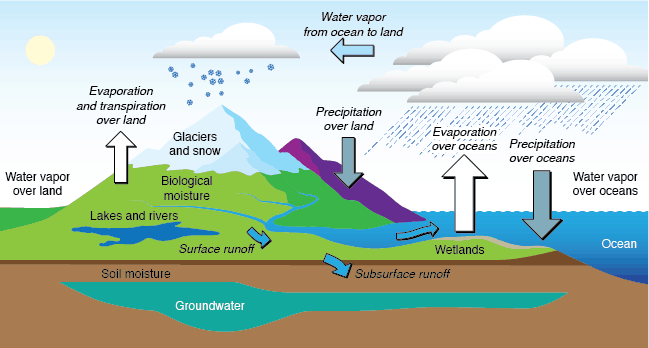Activity Overview: The Sun is a major source of energy on earth. In fact the Sun is the ultimate source of all energy on Earth (except the tides, which come from the effects of the Moon, and nuclear energy). Therefore, the Sun drives one of the most important global processes, the water cycle. In this activity, students will work together to investigate different forms of water, how it moves through the cycle, and the ultimate source of energy for all of the different phases.
Time: 45 minutes of class discussion and demonstrations
First, have students suggest different forms of water in the natural world. Oceans, rivers, lakes, and streams are all made of water. Clouds, steam, and humidity in the atmosphere are also made of water. Ice cubes, glaciers, and ice caps are also made of water. See how many different examples students can observe and fill in the gaps by looking at specific examples online or in books, magazines, or encyclopedias. Illustrate the different examples of water on the board or on a digital canvas.
Then look at some of water’s state transitions that you can produce in your classroom or lab. Allow ice to melt under a warm lamp or in the window. Boil water on a burner or warm it in the microwave to inspire some steam. Catch some steam on a plate, or other tool to show how the water vapor condenses back into liquid water. After illustrating and defining each of these processes, inspire the class to brainstorm about where these processes appear in the wider world. Add these state changes to the illustration
Students should identify that water vapor evaporates from the oceans and then condenses into liquid water again in the atmosphere. Students can also identify that snow and ice from mountains melts to liquid water and then flows down Earth’s terrain back to the oceans. Expand this train of thought to include the different ways water moves around the world: in clouds blown by the wind, in rivers flowing downhill, as ocean currents.
After completing the illustration, bring in the role of the Sun in the water cycle. In the classroom, students could see the source of the heat for evaporation. Ask them what is the source of heat for evaporating the ocean. What about for melting snow and ice? The Sun will shine through as the source of energy for all of these interactions.

Enforce the activity by encouraging students to recreate this diagram in their own notes. You can also find blank versions of the water cycle online for printing or to display on the projector.
TEKS
SCI.4.8B, SCI.5.8B

We'd love to help answer any questions and help you get started! Drop us a line and we'll get back to you as soon as we can.
Watt Watchers of Texas
204 E. Dean Keeton Street, Austin, Texas 78712
contact@watt-watchers.com
Nos encantaría contestarle cualquier pregunta que tenga y ayudarle empezar! Envíenos un mensaje y nos pondremos en contacto con usted lo antes posible.
Watt Watchers de Texas
204 E. Dean Keeton Street, Austin, Texas 78712
contact@watt-watchers.com